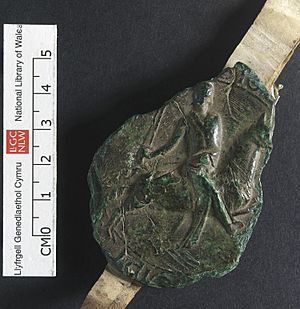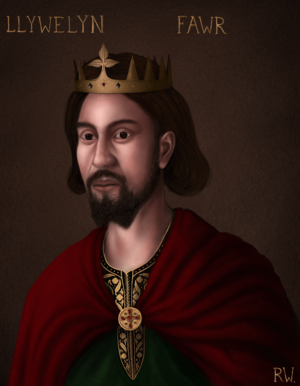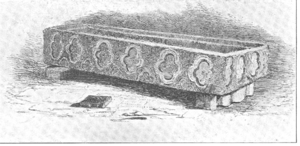Llywelyn the Great facts for kids
Quick facts for kids Llywelyn the Great |
|||||
|---|---|---|---|---|---|
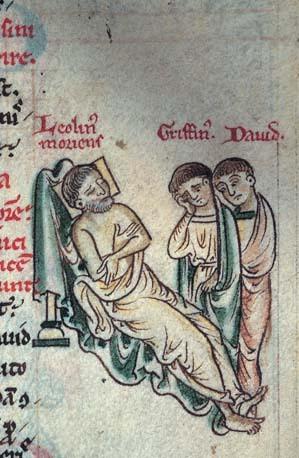
|
|||||
| Prince of Wales | |||||
| Reign | 1228–1240 | ||||
| Predecessor | Rhys ap Gruffydd | ||||
| Successor | Dafydd ap Llywelyn | ||||
| Prince of Gwynedd | |||||
| Reign | 1195–1240 | ||||
| Predecessor | Dafydd ab Owain Gwynedd | ||||
| Successor | Dafydd ap Llywelyn | ||||
| Prince of Powys Wenwynwyn | |||||
| Reign | 1216–1240 | ||||
| Predecessor | Gwenwynwyn | ||||
| Successor | Gruffydd ap Gwenwynwyn | ||||
| Born | c. 1173 Dolwyddelan, Kingdom of Gwynedd |
||||
| Died | 11 April 1240 (aged 66–67) Cistercian Aberconwy Abbey, Principality of Wales |
||||
| Burial | Aberconwy Abbey, Wales | ||||
| Spouse | Joan, Lady of Wales | ||||
| Issue |
|
||||
|
|||||
| Welsh | Llywelyn Fawr | ||||
| House | Aberffraw | ||||
| Father | Iorwerth Drwyndwn | ||||
| Mother | Marared ferch Madog | ||||
Llywelyn the Great (in Welsh, Llywelyn Fawr), born around 1173, was a powerful ruler in Wales. He was known as the Prince of Gwynedd in northern Wales. Later, he became known as the "Prince of the Welsh" and then "Prince of Wales."
Llywelyn ruled for 45 years. He used both fighting and smart agreements to control much of Wales. When Llywelyn was a child, his uncles ruled Gwynedd. They had divided the kingdom after his grandfather, Owain Gwynedd, died in 1170. Llywelyn believed he was the rightful ruler. He started working to gain power when he was young.
By 1200, Llywelyn was the sole ruler of Gwynedd. He made a peace treaty with King John of England. Their relationship was good for about ten years. Llywelyn married King John's daughter, Joan, in 1205. In 1208, he took control of southern Powys.
However, relations with King John worsened in 1210. King John invaded Gwynedd in 1211. Llywelyn had to give up some lands. But he quickly got them back the next year. He joined forces with the English barons who made King John sign the Magna Carta in 1215. By 1216, Llywelyn was the most powerful leader in Wales. He held a meeting at Aberdyfi to divide lands among other Welsh princes.
After King John died, Llywelyn made a new treaty with the new king, Henry III, in 1218. For the next 15 years, Llywelyn often fought with English lords. But he also made important alliances. His military career ended in 1234 with the Peace of Middle. This agreement led to a truce that lasted until he died. Llywelyn kept his strong position in Wales until his death in 1240. His son, Dafydd ap Llywelyn, took over after him.
Contents
Early Life and Family History
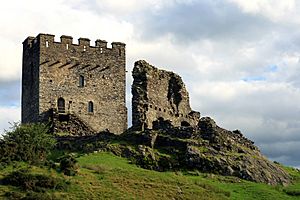
Llywelyn was born around 1173. His father was Iorwerth Drwyndwn, and his grandfather was Owain Gwynedd. Owain Gwynedd had ruled Gwynedd until 1170. Llywelyn came from a very old and important Welsh royal family. He was likely born at Dolwyddelan. This was a royal area, but not in the Dolwyddelan Castle we see today. Llywelyn himself built that castle later. He might have been born in an older castle nearby.
Not much is known about Llywelyn's father, Iorwerth. Iorwerth died when Llywelyn was a baby. Iorwerth was the oldest son of Owain Gwynedd. But he didn't take part in the power struggles after his father's death. Some stories say he had a disability. This might have stopped him from becoming ruler.
A historian named J. E. Lloyd says Iorwerth died in a battle in 1174. This battle was part of the fights over who would rule after Owain Gwynedd.
By 1175, Gwynedd was split between two of Llywelyn's uncles. Dafydd ab Owain ruled the eastern part. Rhodri ab Owain ruled the western part. These uncles were sons of Owain from a second marriage. The church did not see this marriage as proper. So, Llywelyn was seen as the true heir to Gwynedd's throne.
Llywelyn's mother was Marared. She was the daughter of Madog ap Maredudd, a prince from Powys. After Iorwerth died, Marared may have married into an English family. Llywelyn might have spent some of his childhood in England.
Becoming a Powerful Leader (1188–1199)

In 1194, Llywelyn defeated his uncle Dafydd. He had help from his cousins, Gruffudd ap Cynan and Maredudd ap Cynan. This battle happened at Aberconwy, near the River Conwy.
Rhodri died in 1195. His lands were taken by Gruffudd and Maredudd. Llywelyn ruled the lands he took from Dafydd. In 1197, Llywelyn captured Dafydd and put him in prison. A year later, the Archbishop of Canterbury helped free Dafydd. Dafydd then moved to England and died in 1203.
Wales was divided into two main parts. Pura Wallia was ruled by Welsh princes. Marchia Wallia was ruled by English lords. After Owain Gwynedd died in 1170, Rhys ap Gruffydd became the strongest Welsh ruler in the south. He was the leader of Pura Wallia. But Rhys died in 1197. His sons then fought among themselves.
Gwenwynwyn, a prince from Powys, tried to become the new leader of the Welsh. In 1198, he gathered a large army. They tried to capture Painscastle. Llywelyn sent troops to help Gwenwynwyn. But Gwenwynwyn's army was defeated by an English army. This defeat gave Llywelyn a chance to become the main Welsh leader. In 1199, he captured Mold Castle. He began using the title "prince of the whole of North Wales."
Ruling as Prince of Gwynedd
Building Power (1200–1209)
Gruffudd ap Cynan died in 1200. This made Llywelyn the undisputed ruler of Gwynedd. In 1201, he took more land from Maredudd ap Cynan. In July of that year, Llywelyn made a treaty with King John of England. This was the first written agreement between an English king and a Welsh ruler. Llywelyn promised loyalty to the king. In return, he kept his conquered lands. Also, cases about his lands could be heard under Welsh law.
Llywelyn first expanded beyond Gwynedd in 1202. He gathered an army to attack Gwenwynwyn of Powys. Gwenwynwyn was his main rival in Wales. Church leaders stepped in and made peace. So, the invasion was called off. Llywelyn punished Elise ap Madog for not joining his army. He took almost all of Elise's lands.
Llywelyn strengthened his position in 1205. He married Joan, King John's daughter. He had considered marrying his uncle Rhodri's widow, but this plan was dropped.
In 1208, Gwenwynwyn of Powys had problems with King John. John arrested Gwenwynwyn and took his lands. Llywelyn used this chance to take southern Powys and northern Ceredigion. He also rebuilt Aberystwyth Castle. In 1209, Llywelyn joined King John on a military trip against the King of Scotland.
Challenges and Comeback (1210–1217)
In 1210, Llywelyn's relationship with King John got worse. Some historians think it was because Llywelyn allied with William de Braose, 4th Lord of Bramber. William de Braose had fallen out with the king. While John was fighting in Ireland, an English army invaded Gwynedd. Llywelyn destroyed his own Deganwy Castle and moved west. The English rebuilt Deganwy. Llywelyn fought back by attacking English lands. King John sent troops to help Gwenwynwyn get his lands back.
In 1211, King John invaded Gwynedd again with a larger army. He wanted to completely defeat Llywelyn. John's army burned Bangor. Llywelyn had to make peace. He sent his wife Joan to talk with her father, King John. Joan convinced her father not to take all of Llywelyn's lands. But Llywelyn lost all his lands east of the River Conwy. He also had to give a lot of cattle and horses. He gave his son Gruffydd as a hostage. He also agreed that if he died without a legitimate son by Joan, his lands would go to the king.
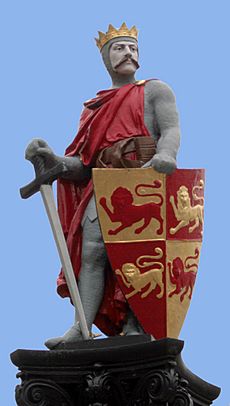
This was a very difficult time for Llywelyn. But he quickly regained his power. The other Welsh princes who had helped King John soon became unhappy with him. They switched sides. Llywelyn formed an alliance with Gwenwynwyn of Powys and the rulers of Deheubarth. They rose up against King John. They also had the support of Pope Innocent III. The Pope had been in a dispute with King John. The Pope freed Llywelyn and the other princes from their loyalty oaths to John. Within two months in 1212, Llywelyn got back almost all of Gwynedd.
King John planned another invasion in August 1212. But he received letters from his daughter Joan and the King of Scotland. Both warned him that his own nobles might turn against him if he invaded Wales. So, John stopped the invasion. In 1213, Llywelyn captured Deganwy and Rhuddlan castles. Llywelyn then allied with the King of France. He also joined the English barons who were rebelling against King John. Llywelyn captured Shrewsbury in 1215 without a fight. When John was forced to sign the Magna Carta, Llywelyn gained good terms for Wales. This included the release of his son, Gruffydd.
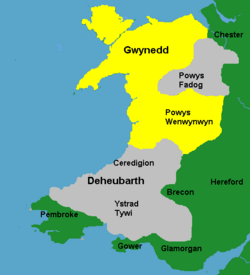
Llywelyn was now the clear leader of the independent Welsh princes. In December 1215, he led an army to capture several castles in South Wales. He also made sure Welshmen were appointed as bishops.
In 1216, Llywelyn held a meeting at Aberdyfi. He settled land claims among the smaller princes. They all promised loyalty to Llywelyn. This showed that Llywelyn was now their lord. Gwenwynwyn of Powys changed sides again and allied with King John. Llywelyn attacked him and drove him out of southern Powys. Gwenwynwyn died later that year. King John also died that year. Both left young heirs.
In 1217, Reginald de Braose, an English lord, switched his loyalty to the English king. Reginald was married to Llywelyn's daughter, Gwladus Ddu. Llywelyn responded by invading Reginald's lands. He captured towns and castles, showing his power.
Treaty and Border Fights (1218–1229)
After King John's death, Llywelyn made the Treaty of Worcester with King Henry III in 1218. This treaty confirmed that Llywelyn could keep all the lands he had recently won. From then until his death, Llywelyn was the most powerful person in Wales. He still had some fights with English lords and sometimes with the king.
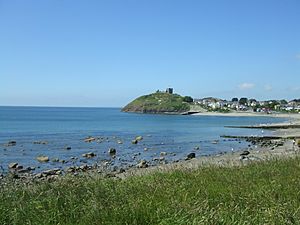
Llywelyn made alliances with several English border families through marriages. His daughter Gwladus Ddu was married to Reginald de Braose. Another daughter, Marared, married Reginald's nephew, John de Braose. Llywelyn also found a loyal ally in Ranulph, Earl of Chester. Ranulph's nephew, John the Scot, married Llywelyn's daughter Elen around 1222. After Reginald de Braose died in 1228, Gwladus Ddu married Ralph de Mortimer, a powerful lord.
Llywelyn was careful not to cause unnecessary fights. For example, in 1220, he made a Welsh prince return lands to their English owners. He built many castles to protect his borders. These were the first advanced stone castles in Wales. His castles at Criccieth, Deganwy, Dolbadarn, Dolwyddelan, and Castell y Bere are great examples. Llywelyn also helped develop towns in Gwynedd for trade.
Fighting broke out with William Marshal in 1220. Llywelyn destroyed castles and burned towns. He threatened Pembroke Castle but agreed to stop for a payment. In 1223, Llywelyn captured two castles in England. The Marshals used this chance to recapture Cardigan and Carmarthen. Llywelyn made an agreement with the king later that year. Llywelyn's allies got their lands back. Llywelyn gave up his English conquests.
In 1228, Llywelyn fought against Hubert de Burgh. Hubert was a very powerful man in England. Hubert was taking over Llywelyn's lands near Montgomery. The king sent an army to help Hubert. But the royal army had to retreat. King Henry agreed to destroy a new castle if Llywelyn paid £2,000. Llywelyn got this money by demanding it as ransom for William de Braose, whom he had captured.
Family Matters (1230)
After his capture, William de Braose decided to become Llywelyn's ally. A marriage was planned between William's daughter Isabella and Llywelyn's son, Dafydd. In 1230, William visited Llywelyn's court. During this visit, William was found in Llywelyn's private area with Llywelyn's wife, Joan. On May 2, William de Braose was executed. Joan was kept under house arrest for a year. The Welsh chronicle Brut y Tywysogion recorded that William de Braose was executed by Llywelyn after being found with Llywelyn's wife.
Llywelyn wrote to William's wife, Eva de Braose, asking if she still wanted the marriage between Dafydd and Isabella to happen. The marriage did take place. The next year, Joan was forgiven and returned to her role as princess.
Until 1230, Llywelyn called himself 'Prince of North Wales'. After that, he changed his title to 'Prince of North Wales and Lord of Snowdonia'. This might have been to show his power over other Welsh princes. He didn't officially call himself 'Prince of Wales'. But he had much of the power that title would mean.
Last Campaigns and Peace (1231–1240)
In 1231, there was more fighting. Llywelyn was worried about Hubert de Burgh's growing power. Some of Llywelyn's men were captured and executed. Llywelyn reacted by burning towns and capturing castles. He finished the campaign by taking back Cardigan castle. King Henry invaded in return. He built a new castle at Painscastle. But he could not go far into Wales.
Talks continued into 1232. Hubert de Burgh was removed from his position. Much of his power went to Peter de Rivaux. William Marshal had died in 1231. His brother Richard became Earl of Pembroke. In 1233, fighting started between Richard Marshal and Peter de Rivaux. King Henry supported Peter. Llywelyn allied with Richard. In January 1234, they captured Shrewsbury. Richard was killed in April. But the king agreed to make peace. The Peace of Middle, agreed on June 21, set a two-year truce with Llywelyn. He was allowed to keep Cardigan and Builth. This truce was renewed every year until Llywelyn died.
Death and What Happened Next
Planning for the Next Ruler
In his later years, Llywelyn worked hard to make sure his only legitimate son, Dafydd, would become the next ruler of Gwynedd. He changed Welsh law to favor legitimate children born in a church-approved marriage. This was a new idea in Wales. It aimed to help Dafydd have better relations with the English and the Church. Dafydd's older half-brother, Gruffydd, was not the primary heir. However, Gruffydd was given some lands to rule.
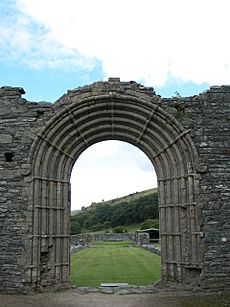
In 1220, Llywelyn convinced King Henry's government to accept Dafydd as his heir. In 1222, he asked Pope Honorius III to confirm Dafydd's succession. The Pope agreed, praising Llywelyn for ending the custom where illegitimate sons had equal rights to inheritance. In 1226, Llywelyn persuaded the Pope to declare his wife Joan, Dafydd's mother, as a legitimate daughter of King John. This further strengthened Dafydd's claim. In 1229, the English crown accepted Dafydd's loyalty for the lands he would inherit. In 1238, Llywelyn held a council at Strata Florida Abbey. There, other Welsh princes swore loyalty to Dafydd. Llywelyn also arranged for Dafydd to marry Isabella de Braose. Since Isabella's father had no male heir, Llywelyn hoped her family's lands would pass to Dafydd's children.
Gruffydd was given lands in Meirionnydd and Ardudwy. But his rule was said to be harsh. In 1221, Llywelyn took these lands back. In 1228, Llywelyn imprisoned Gruffydd. He was not released until 1234. After his release, he was given part of Llŷn to rule. This time, he did better. By 1238, he had more land in Llŷn and Powys.
Llywelyn's Death and What Followed
Joan died in 1237. Llywelyn seems to have had a stroke that same year. From then on, his son Dafydd took a bigger role in ruling. Dafydd took lands from his half-brother Gruffydd. He later captured Gruffydd and his oldest son, Owain. They were held in Criccieth Castle. The Welsh chronicle says that in 1240, "the lord Llywelyn ap Iorwerth... Prince of Wales, a second Achilles, died." He had become a monk at Aberconwy before his death.
Llywelyn died at Aberconwy Abbey, which he had founded. He was buried there. The abbey later moved to Maenan, near Llanrwst. Llywelyn's stone coffin can now be seen in St Grwst's Church, Llanrwst. Poets wrote sad poems about his death.
Dafydd became prince of Gwynedd after Llywelyn. But King Henry was not willing to let him inherit all of his father's power in Wales. Dafydd had to agree to a treaty that greatly limited his power. He also had to hand his half-brother Gruffydd over to the king. The king could then use Gruffydd against Dafydd. Gruffydd was killed trying to escape from the Tower of London in 1244. This left Dafydd as the clear ruler. But Dafydd himself died in 1246. He was eventually succeeded by his nephew, Gruffydd's son, Llywelyn ap Gruffudd.
How History Remembers Him
Llywelyn was a dominant figure in Wales for over 40 years. He is one of only two Welsh rulers called "the Great." The other was his ancestor, Rhodri the Great. The English writer Matthew Paris was one of the first to call Llywelyn "the Great."
Llywelyn's Children
Llywelyn married Joan, King John of England's daughter, in 1205. Llywelyn and Joan had several children. Not much is known about Llywelyn's other partner, Tangwystl Goch. The mothers of some of Llywelyn's children before his marriage to Joan are not certain.
- Children by Joan
- Dafydd ap Llywelyn (born around 1212, died 1246)
- Gwladus Ddu (1206–1251), who married Reginald de Braose and later Ralph de Mortimer. She had children.
- Elen ferch Llywelyn (Helen or Ellen) (1207–1253), married John the Scot and later Robert II de Quincy.
- Susanna ferch Llywelyn (died after November 1228).
- Marared ferch Llywelyn (died after 1268), married John de Braose in 1219, and later Walter III de Clifford. She had children from both marriages.
- Elen the Younger ferch Llywelyn (born before 1230, died after 1295). She married Máel Coluim II, Earl of Fife and later Domhnall I, Earl of Mar. Her daughter, Isabella of Mar, married Robert the Bruce, King of Scots.
- Children by Tangwystl Goch (died around 1198)
- Gruffydd ap Llywelyn (born around 1196, died 1244). He was Llywelyn's oldest son. He married Senena. Their sons included Llywelyn ap Gruffudd, who became a powerful ruler like his grandfather, and Dafydd ap Gruffydd.
- Children whose mother is uncertain
- Angharad ferch Llywelyn (born around 1212, died 1256), likely a daughter by Joan. She married Maelgwn Fychan.
- Tegwared y Baiswen ap Llywelyn (born around 1215), a son.
Family Tree
| Llywelyn | |||||||||||||||||||||||||||||||||||||
| Gruffydd ap Llywelyn 1200–1244 |
Dafydd ap Llywelyn 1212–1240–1246 |
||||||||||||||||||||||||||||||||||||
| Owain Goch ap Gruffydd d. 1282 |
Llywelyn ap Gruffudd 1223–1246–1282 |
Dafydd ap Gruffydd 1238–1282–1283 |
Rhodri ap Gruffudd 1230–1315 |
||||||||||||||||||||||||||||||||||
| Gwenllian of Wales 1282–1337 |
Llywelyn ap Dafydd 1267–1283–1287 |
Owain ap Dafydd 1275–1287–1325 |
Tomas ap Rhodri 1300–1325–1363 |
||||||||||||||||||||||||||||||||||
| Owain Lawgoch 1330–1378 |
|||||||||||||||||||||||||||||||||||||
Llywelyn in Stories and Books
Many Welsh poems from Llywelyn's time still exist. They were written by poets like Cynddelw Brydydd Mawr.
Llywelyn is also a character in modern Welsh literature. The play Siwan (1956) by Saunders Lewis tells the story of William de Braose's execution. Another famous Welsh play about him is Llywelyn Fawr by Thomas Parry.
Llywelyn is a main character in several English novels:
- Raymond Foxall's Song for a Prince: The Story of Llywelyn the Great (1959) covers part of his reign.
- Sharon Kay Penman's Here Be Dragons (1985) focuses on Llywelyn and Joan's marriage. Her book Dragon's Lair (2003) features a young Llywelyn.
- Edith Pargeter's "The Heaven Tree Trilogy" (1960–63) includes Llywelyn and his family as important characters.
- Gaius Demetrius's Ascent of an Eagle (2006) tells about the early part of Llywelyn's rule.
The famous story of the faithful dog Gelert is also linked to Llywelyn. In the story, Llywelyn mistakenly kills his loyal dog. "Gelert's grave" is a popular place to visit in Beddgelert. However, the story is believed to be a folktale. It was likely created by an innkeeper in the 1700s to attract tourists.
Images for kids
See also
 In Spanish: Llywelyn el Grande para niños
In Spanish: Llywelyn el Grande para niños


